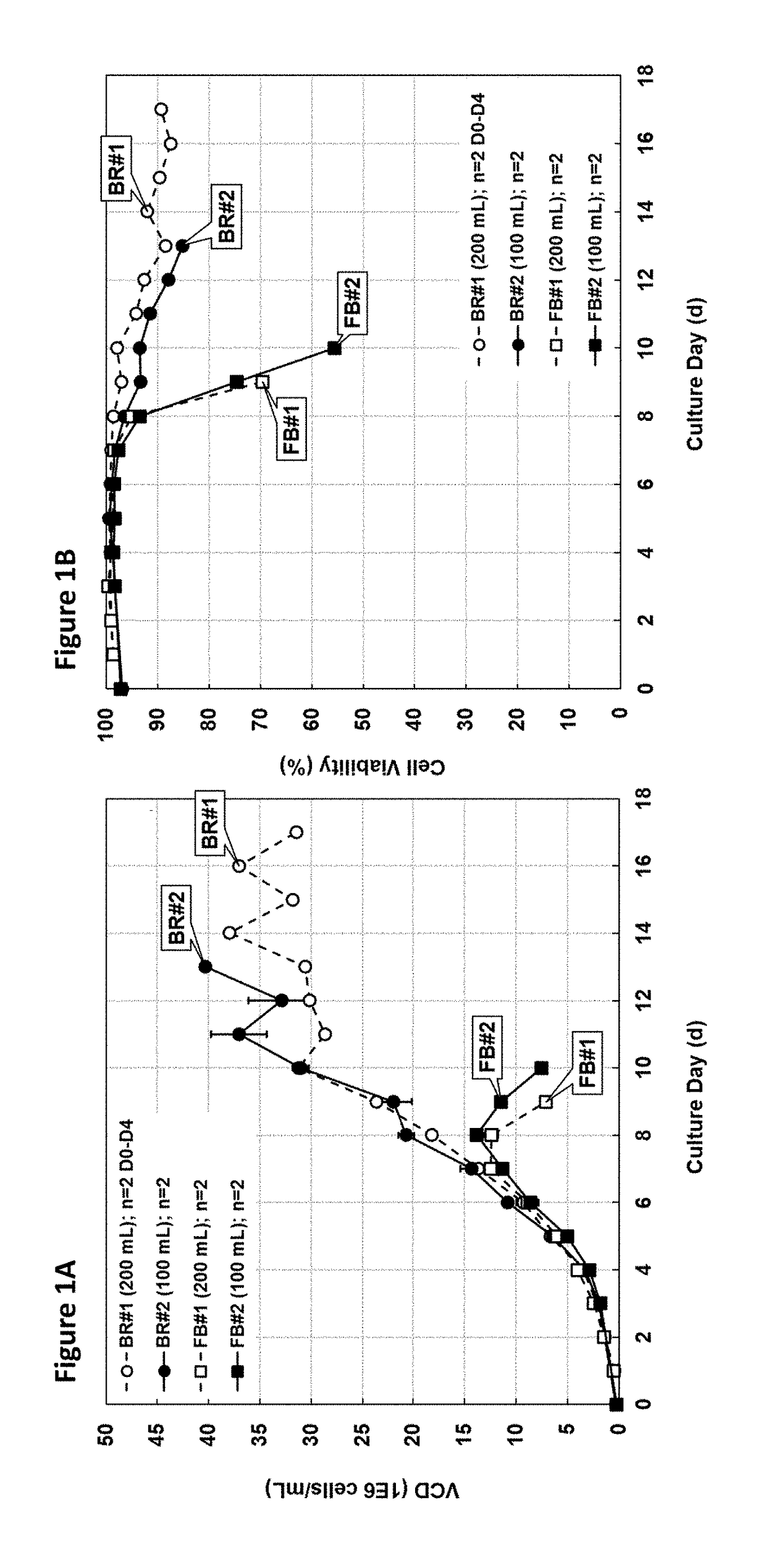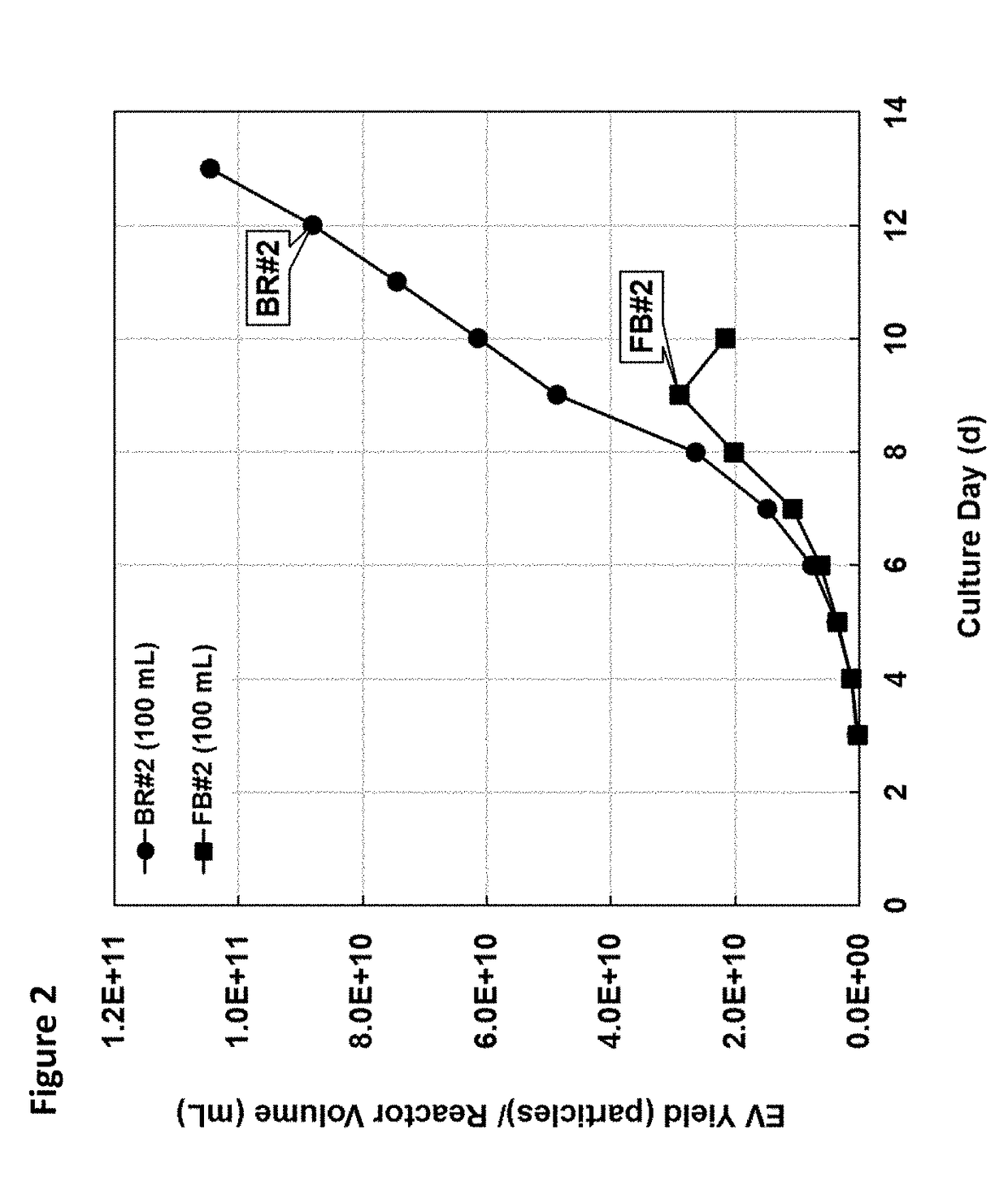Production of Extracellular Vesicles in Single-Cell Suspension using Chemically-Defined Cell Culture Media
a cell culture and single-cell technology, applied in the field of extracellular vesicles, can solve the problems of reducing the yield of exosomes in the cell culture process without animal-derived components at every process stage, and achieving the effect of low cost, reliable and efficient high-titer production
- Summary
- Abstract
- Description
- Claims
- Application Information
AI Technical Summary
Benefits of technology
Problems solved by technology
Method used
Image
Examples
example 1
in Chemically-Defined Culture Medium Yields High Cell Densities, and Batch Re-Feed Culturing Yields Higher Cell Densities than Fed-Batch Cultures
[0117]Cell culture growth obtained in simulated perfusion cultures was compared to that obtained in fed-batch cultures. Cultures were inoculated at ˜0.3-0.5E6 viable cells / mL with HEK293 SF cells in shake flasks in the same basal cell culture medium and cultured either in fed-batch (FB) or batch-refeed (BR) mode for up to 16 days. Starting from day three, feed was added to the fed-batch cultures as described in the Methods section, and the batch-refeed cultures were spun down daily and one reactor volume of spent medium was exchanged with one reactor volume of fresh basal medium (1 RV / d) following cell resuspension. Based on the cell growth results, ˜35E6 cells / mL were successfully maintained for about a week in batch-refeed at >85% viability, while only about 12-14E6 cells / mL could be reached in fed-batch before cell viabilities dropped be...
example 2
eed Culturing Yields Higher EV Titers than Fed-Batch Cultures
[0118]To determine whether the higher cell densities achieved in batch refeed translated to higher cumulative EV titer, EV titer was determined by analysis of intrinsic fluorescence (FIG. 2). More importantly, however, the maximum final yield obtained in a 9-day fed-batch was ˜3E12 particles / 100 mL vessel volume, while maintaining the cultures in batch refeed at approximately 2.5× higher cell density resulted in volumetric productivity of ˜1.3E10 EV / mL / d. In a 9-day batch-refeed steady-state process maintaining ˜35E6 viable cells / mL, this volumetric productivity would translate to about 3-fold higher EV yield with the batch refeed culture harvest from a vessel volume of the same size as compared to that of the fed-batch (FIG. 3).
example 3
eed Culturing Yields More Pure EV Harvest Profiles than Fed-Batch Cultures
[0119]HPLC chromatograms were evaluated for consistency throughout the culture durations. Analysis of anion exchange chromatograms revealed EV harvest profiles with reduced contamination for the batch-refeed culture as compared to fed-batch (FIGS. 4A-F). First, an increase of smaller / less negatively charged species in the elute was noted starting from day 9 in fed-batch, while a sharp intensity peak continued to elute at ˜8.5 min throughout the batch-refeed culture (FIGS. 4A, D). In addition, more of the larger / more negatively charged species were also measured on day 10 in fed batch (FIG. 4A). Secondly, the fluorescence profiles tracking proteinaceous content, including small molecules, metabolites, membranous contaminants, and combinations thereof, in the harvest were almost 10-fold higher in the fed batch compared to batch refeed (FIGS. 4B, E). Finally, a more diverse population of mostly nucleic acid speci...
PUM
 Login to View More
Login to View More Abstract
Description
Claims
Application Information
 Login to View More
Login to View More - R&D
- Intellectual Property
- Life Sciences
- Materials
- Tech Scout
- Unparalleled Data Quality
- Higher Quality Content
- 60% Fewer Hallucinations
Browse by: Latest US Patents, China's latest patents, Technical Efficacy Thesaurus, Application Domain, Technology Topic, Popular Technical Reports.
© 2025 PatSnap. All rights reserved.Legal|Privacy policy|Modern Slavery Act Transparency Statement|Sitemap|About US| Contact US: help@patsnap.com



